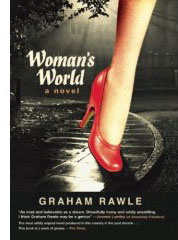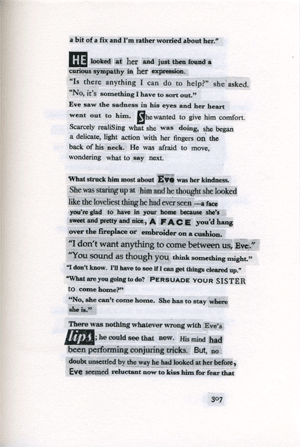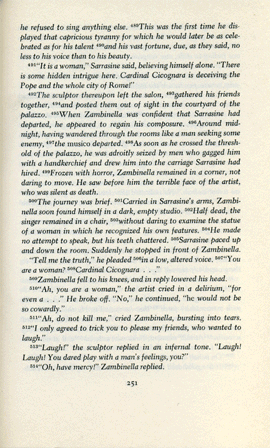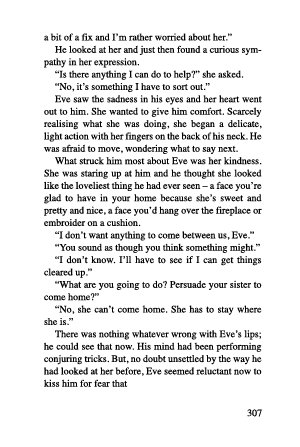 In a sense, Graham Rawle‘s novel Woman’s World, just out in the United States from Counterpoint, is made for the internet. It’s the sort of thing that you expect to see on Digg or Reddit: artist spends several years cutting up old women’s magazines and laboriously constructs a 400-page novel out of the collaged shards of text. If the internet loves anything, it’s novelty, and Rawle’s work is certainly that. Every spread of the book is beautiful – here’s one chosen at random:
In a sense, Graham Rawle‘s novel Woman’s World, just out in the United States from Counterpoint, is made for the internet. It’s the sort of thing that you expect to see on Digg or Reddit: artist spends several years cutting up old women’s magazines and laboriously constructs a 400-page novel out of the collaged shards of text. If the internet loves anything, it’s novelty, and Rawle’s work is certainly that. Every spread of the book is beautiful – here’s one chosen at random:
I show one spread, though I could as easily have shown 200 others. Rawle’s work is supremely visual, and invites the reader to appreciate in that way. In a sense, it puts off serious readings: it’s constructed from women’s magazines of the 1950s and 60s, which society accords little value to: magazines are ephemeral, fashion magazines inherently so. But such readings, inevitable as they may be, are unjust to Rawle’s book, which deserves to be read as a novel. While emphatically a work of print, the way Rawle uses text can shed light on the way we use text online.
What goes on in Woman’s World? Rawle’s raw materials suggest his subject matter: it’s a novel about clothes, specifically women’s clothes. It’s not a stretch to imagine that his working method suggested his plot: Rawle, a mail artist, uses women’s words to construct a book; his male protagonist garbs himself in women’s clothes. Clothes become language: Rawle stitches words and phrases together to make something new. (A parallel might be drawn to Georges Perec’s use of constraint in La Disparition/A Void, a work of art not because it does away with the letter e – that had been done before – but because Perec’s technique informs his narrative; the informed reader sees the novel’s themes of disappearance and loss as Perec’s method of indirectly writing about the disappearance of his parents in the Holocaust.)
It’s worth paying close attention to how the creator works. Rawle generally cuts on the phrase level, going down to the word level. Occasionally a suffix is added (-s, -ed). It’s only once in a great while that he edits inside the word. On p. 307 (below left), the eye is drawn to word “realising”, where the American spelling “realizing” has been changed to the British “realising” by pasting an s over a z. (From the spelling, Rawle seems to be mining British magazines, another reason for this word to stand out.) It’s hard not to take this as a sign pointing to to another narrative about transvestites where things end badly, Honoré de Balzac’s “Sarrasine”, a short story best known to English readers from its appearance as an appendix in Roland Barthes’s book-length reading of it, S/Z. In that book, Barthes dissected “Sarrasine” into 561 narrative units he called “lexias” in which he discovered five different codes underlying and structuring the text. Balzac’s story appears twice in S/Z: once interpolated with Barthes’s notations over 220 pages, and again in an appendix to the book, interpolated by the numerals numbering the lexias Barthes found in the story. Displayed on the page like this – an example is below right – “Sarrasine” feels like Frankenstein’s monster, constructed from numbered parts of language; a great-uncle, perhaps, of Rawle’s text. There’s at least a faint family resemblance:


Just as Barthes finds structures by which to decipher what the reader experiences in “Sarrasine”, there can be found structures to decipher what the reader experiences when reading Woman’s World. At one level, there is the story – a sequence of words that could be put into a .TXT file and be exactly the same. At another level, there’s the presentation. This is something that’s hard to precisely pin down, but it’s best explained by pointing out the difference between reading a plain text version of Rawle’s story and the collaged version of the same. Try looking at Rawle’s p. 307 and my neutral typesetting of it (click on each for a better view):
Something is lost in my translation, though most don’t have the vocabulary to describe what that is. (Tom Phillips, no stranger to this sort of thing, gives the book a close reading in his Guardian review that suggests that such a thing is possible with a background in graphic design.) But try to read these two versions of the same page aloud and note the difference: the first full sentence in Rawle’s version has a front-loaded stress (“HE looked at her”) that isn’t apparent from the words alone. The same sentence feels choppy because it’s cut into individual words at first; it seems to speed up when it gets to “and just then found,” a whole phrase. An eye more attuned to the nuances of type is bound to notice more of these connotations; and certainly this seems conscious on Rawle’s part.
On a third level, there’s the apparent history of Rawle’s bits of text: its referentiality. Every letter of Rawle’s text clearly comes from somewhere else; sometimes he takes as many as several sentences. The original context isn’t always clear, though it can quite often be guessed. (Extended excerpts aren’t always needed to do this: sometimes a single decorative letter is enough to suggest that it originally served as an ad.) Rawle’s language is explicitly secondhand. In a sense, though, it’s no more secondhand than any other language. We use words and phrases because others have used those words and phrases before us (or, more pretentiously, we hope that others will use ours) and those words and phrases suggest our previous conversations, reading, and cultural contexts. Language carries its history with it.
(Perhaps I didn’t need to go to Barthes to point this out: one remembers the best moment in The Devil Wears Prada is a scene in which Meryl Streep, playing Anna Wintour, upbraids the movie’s idiotic anti-hero Anne Hathaway, for declaring that fashion is meaningless and that her constant demands are similarly petty and meaningless. Streep responds fluently in the language of fashion, spinning off a history of color, texture, and cut, proceeding from designer to designer, through connotations and denotations, until she reaches the nameless maker of Hathaway’s rather non-descript blue cardigan, which carries a world of associations even if worn by the unaware.)
Language is a complicated thing that we tend to take for granted. Looking at Rawle’s novel suggests how loaded simple text can be. It’s worth considering how comparatively limited reading on the Internet seems to be. Consider this text: I’m writing it in black 14 point Avenir Roman, though when it appears on the blog, my best guess is that you’ll see it in 13 point Verdana in a dark gray. That could be, of course, entirely wrong: the browser environment (and RSS readers) give viewers a great deal of freedom in defining how their text looks. But that’s a small point in comparison with the third code I find in Rawle, the referentiality of his pieces of text. For all the interlarding of scans in this post, it appears to be a seamless whole – you, the reader, have no reason for not thinking that I didn’t start at the first sentence and write furiously until I came to the last sentence, and I would be more than happy not to disabuse you of the notion. Had this piece been written as a Wikipedia article, you might have some notion of how this was created, though it’s still very difficult to visualize exactly where a Wikipedia article comes from: while the prose of a typical Wikipedia article is lumpy, it has nowhere near the eloquent texture of Rawle’s pages.
Could an electronic Woman’s World be made? Another parallel could be drawn, to Ted Nelson’s idea of transclusion, the concept of keeping quoted texts connected to their original sources. Transclusion was an early hypertext hope, though results so far have been generally disappointing; it’s not quite so easy as cutting and pasting, though Nelson’s appealingly low-tech diagrams might suggest this. There’s a way to go yet.

